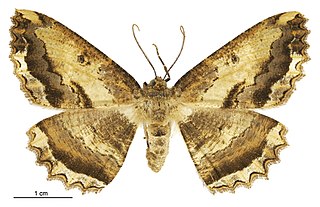
Senecio is a genus of flowering plants in the daisy family (Asteraceae) that includes ragworts and groundsels. The scientific name, Senecio, means "old man".

Agapanthus is the only genus in the subfamily Agapanthoideae of the flowering plant family Amaryllidaceae. The family is in the monocot order Asparagales. The name is derived from Greek: ἀγάπη, ἄνθος.

The Crambidae are the grass moth family of lepidopterans. They are variable in appearance, the nominal subfamily Crambinae taking up closely folded postures on grass stems where they are inconspicuous, while other subfamilies include brightly coloured and patterned insects which rest in wing-spread attitudes.

Senecio angulatus, also known as creeping groundsel and Cape ivy, is a succulent flowering plant in the daisy family that is native to South Africa. Cape ivy is a scrambling and a twining herb that can become an aggressive weed once established, making it an invasive species in some regions, such as Australasia. However, in the Mediterranean Basin, it is grown as an ornamental plant for its satiny foliage and sweet-scented flowers.

Curio archeri, syn. Senecio toxotis is a species of succulent plant in daisy family that is indigenous to the south-western Cape, South Africa.

Gellonia dejectaria, the brown evening moth, is a moth in the family Geometridae. The species was first described by Francis Walker in 1860. It is endemic to New Zealand.

Pseudocoremia fenerata is a moth of the family Geometridae. It is endemic to New Zealand.
Stigmella kaimanua is a moth of the family Nepticulidae which is endemic to New Zealand.

Stigmella ogygia is a moth of the family Nepticulidae. It is found in New Zealand.

Chilo suppressalis, the Asiatic rice borer or striped rice stemborer, is a moth of the family Crambidae. It is a widespread species, known from India, Sri Lanka, China, eastern Asia, Japan, Taiwan, Malaysia to the Pacific.

Busseola fusca is a species of moth that is also known as the maize stalk borer. It is known from Ethiopia.

Chloroclystis inductata is a moth of the family Geometridae. It is endemic to New Zealand. It was first described by Francis Walker in 1862. The male of this species can be easily identified by the distinctive 'scalloping' of the hindwings.

Glyphipterix achlyoessa, commonly known as the cocksfoot stem borer, is a species of moth in the family Glyphipterigidae. It is endemic to New Zealand.
Kiwaia lithodes is a moth in the family Gelechiidae. It was described by Edward Meyrick in 1886. It is found in New Zealand.
Megacraspedus calamogonus is a moth of the family Gelechiidae. It was described by Edward Meyrick in 1885. It is endemic to New Zealand.

The lemon tree borer, also known as the whistling beetle or the singing beetle, is a longhorn beetle endemic to New Zealand. Its larvae are generalist feeders, boring into the wood of a wide variety of trees, native and introduced. When citrus orchards were first established in New Zealand, this beetle started inflicting serious damage, and so gained the name "lemon tree borer". Four species within the genus Oemona have been identified, suggesting that more species could be found. When disturbed by predators or humans, the adult beetle stridulates creating a "rasp" or "squeak" sound by rubbing its thorax and head together against an area of thin ridges. Māori would eat a liquid called "pia manuka", which was produced by manuka trees when its wood was damaged by the larva. When Captain Cook first arrived in NZ, his naturalists, Banks and Solander, collected a lemon tree borer in their first collection between 1769-1771. This oldest collected specimen can be found in the British Museum. A few years after the first collection, the species would be first described by the Danish naturalist Fabricius in 1775.
Patagoniodes is a snout moth genus in the subfamily Phycitinae described by Rolf-Ulrich Roesler in 1969.

Curio talinoides, syn. Senecio mandraliscae, also known as blue straws, blue chalksticks, dassieharpuis, or narrow-leaf chalk sticks, is a succulent plant of the sunflower family that is native to South Africa. The origin of this plant is dubious and it may be a hybrid.

Senecio quadridentatus is native to Australia and New Zealand. In New Zealand it is known by its Māori name pahokoraka or pekapeka. Senecio quadridentatus is an annual or perennial herbaceous flowering plant in the aster family. It is also known as Erechtites quadridentata Labill by the synonyms.















